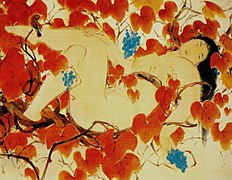Kawabata Ryushi
Kawabata Ryūshi ( Japanese 川端 龍 子 ; born June 6, 1885 in Wakayama ; died April 10, 1966 ) was a Japanese painter in the Nihonga style of the Shōwa period .
life and work
Kawabata went to Tokyo in 1895. From 1904 he attended the Hakuba School ( 白馬 会 , Hakuba-kai ) for Western painting, while he also attended the Pacific School ( 太平洋 画 会 研究所 , Taiheiyō gakai kenkyūjo ). In 1907 he submitted pictures to the industry exhibition in Tōkyō Prefecture and to the first exhibition of the Ministry of Culture, the Mombusho bijutsu tenrankai ( 文部省 美術展 覧 会 ).
From 1908 Kawabata worked for the Kokumin newspaper and provided illustrations for it. Among his colleagues there was the Nihonga painter Hirafuku Hyakusui , who had a strong influence on him. He also contributed illustrations for the satirical magazine Tōkyō Puck and the manga magazine Shōnen Puck .
In 1913 Kawabata traveled through the United States, where he was very impressed by the oriental painting that he saw in the Boston Museum of Fine Arts . This led to a switch to Nihonga painting, and upon his return he became a member of the Musei-kai. He showed his pictures in the exhibitions of the revived Nihon Bijutsuin from his second exhibition in 1915. There he showed pictures such as "Adoration of the Light of Grace" ( 慈悲光 礼 讃 , Jihikō raisan ), "Printed Indian cotton" ( イ ン ド サ ラ サ ラ , Indo sarasara ) . Kawabata's painting in Nihonga style with a hint of Western painting made him famous.
In 1928, Kawabata separated from the Bijutsuin exhibitions and founded the Seiryū-sha ( 青龍 社 ). He now advocated a more ornamental and decorative image representation in large formats in contrast to traditional Nihonga painting, which is more oriented towards the size of the tokonoma . Wall screens like “ Naruto ” ( 鳴 門 ; 1929) “Fish pattern” ( 魚紋 , Gyomon ) “Spring music ” ( 新春 の 曲 , Shinshun no kyoku ) are examples of this style.
In 1930 Kawabata received the Asahi Prize , in 1935 he became a member of the Imperial Academy of Arts and then the successor organization, but left this institution. - The well-known works of Kawabata include the humorous " Otter als Priester" ( 獺 祭 , Dassai ) and "Träume" ( 夢 , Yume ).
In 1959, Kawabata was named a person with special cultural merits and was awarded the Order of Culture at the same time . - In 1961, Kawabata's studio was converted into a museum by the Seiryū-sha. After the association was dissolved, the Ōta in Tokyo took over the museum in 1991 .
photos
Remarks
- ↑ This picture (Japanese 愛 染 , Aizen ) appeared as a postage stamp for the Japanese Post in 1974 on the occasion of the 16th Conference of the Inter-Parliamentary Union in Japan.
- ↑ The Kokumin Shimbun ( 国民 新聞 ) was published between 1890 and 1942.
literature
- S. Noma (Ed.): Kawabata Ryūshi . In: Japan. An Illustrated Encyclopedia. Kodansha, 1993, ISBN 4-06-205938-X , p. 760.
- Tazawa, Yutaka: Kawabata Ryūshi . In: Biographical Dictionary of Japanese Art. Kodansha International, 1981. ISBN 0-87011-488-3 .
- Laurance P. Roberts: Kawabata Ryūshi . In: A Dictionary of Japanese Artists. Weatherhill, 1976. ISBN 0-8348-0113-2 .
Individual evidence
- ↑ 川端 龍 子 . Kokugakuin University , accessed May 27, 2017 (Japanese).
Web links
| personal data | |
|---|---|
| SURNAME | Kawabata, Ryūshi |
| ALTERNATIVE NAMES | 川端 龍 子 (Japanese); Kawabata, Shōtarō (real name); 川端 昇 太郎 (real name, Japanese) |
| BRIEF DESCRIPTION | Japanese painter |
| DATE OF BIRTH | June 6, 1885 |
| PLACE OF BIRTH | Wakayama |
| DATE OF DEATH | April 10, 1966 |





